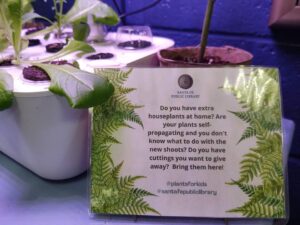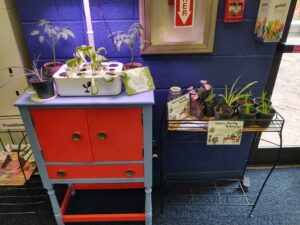The Children’s Plant Exchange is an innovative new program at the Oliver La Farge Branch of the Santa Fe Public Library where children can receive small plant “starts”. Recently Kelly McCabe, Youth Services Coordinator at the New Mexico State Library, reached out to Lydia O’Reilly, Children & Youth Services Librarian at La Farge, to learn more about the creation of the program and how it has impacted their branch.
NMSL: Where did the idea for the program come from?
Lydia O’Reilly: The idea came when I was repotting some of my own houseplants at home. I’m a bit of a plant lady (I had 56 houseplants at last count – It’s getting out of control!) Many of my houseplants were self-propagating, and baby aloes, spider plants, and others were popping up in my already-occupied pots. Often I pull up the baby plants and repot them in their own pots, and the cycle starts again…I thought, Why not gives these to kids that come into the library? I saw how excited kids would get over earning prizes in the Summer Reading Program, but those are often plastic toys. I thought plants would be a good counter-balance to that and something that kids would feel proud of taking care of on their own. Kids feel so empowered when they are entrusted by an adult to take care of something. I remember how as a kid, things that were seemingly routine and mundane to adults felt huge to me when I was invited to participate—whether that be baking a loaf of banana bread with my neighbor, helping find things on the grocery list, or repotting a houseplant. I still have a Christmas cactus plant grown from a neighbor’s cutting 25 years ago. Such a simple thing, and yet it’s been with me my whole life.
 This program is really part of a larger effort to bring the outdoors into the library. We have worked hard this year to breathe new life into our Children’s Courtyard, and turn what was once a sad, brambly, uninviting trash corner into a vibrant children’s garden with veggies, flowers, and herbs; fairy houses, bird houses, and bug hotels; outdoor activities like bug-catching kits, sidewalk chalk, and giant chess; and a stage (which my dad and I built together!) for storytimes and performances. We have been doing lots of programing in the Children’s Courtyard this summer, and it is always open for kids to play in or read in when they visit the library. It’s made a huge difference.
This program is really part of a larger effort to bring the outdoors into the library. We have worked hard this year to breathe new life into our Children’s Courtyard, and turn what was once a sad, brambly, uninviting trash corner into a vibrant children’s garden with veggies, flowers, and herbs; fairy houses, bird houses, and bug hotels; outdoor activities like bug-catching kits, sidewalk chalk, and giant chess; and a stage (which my dad and I built together!) for storytimes and performances. We have been doing lots of programing in the Children’s Courtyard this summer, and it is always open for kids to play in or read in when they visit the library. It’s made a huge difference.
NMSL: What was needed to start-up the program and how does it work?
LO: I started by just bringing in my own plant starts from home! I made a sign and raffle slips, put out a jar, and almost immediately kids started putting their names in. Once we put it on social media, more and more library patrons came in to donate plants. We have so many plants right now that they can’t fit on the display, and I am drawing four or five names a week, instead of one, like I had initially intended.
Ongoing costs are very minimal. Patrons donated old plastic plant containers you get at the nursery, and all of the plants have been donated. We bought a bag of potting soil for separating large plants and replanting baby shoots, but most of the time when someone brings in plants to donate, they have already repotted them into individual containers. Many people (like me) have way too many plants at home and don’t know what to do with all the new shoots and sprouts—this gives them a place to go!
For any plant that is donated, I tell staff to bring it to my office first, so that I can make sure it is non-toxic and suitable for kids. Then they go on display in the Children’s Room!
“It makes sense for this sort of community exchange program to be at a library. It widens the accessibility of plant-growing for kids who may not be able to afford purchasing their own plants, or who otherwise experience barriers to nature-based learning.”
NMSL: How has it been received?
LO: Kids and parents both are loving it. Kids get psyched to take home their very own plant and learn how to raise it. The way some kids react, you’d think we are giving out puppies! It’s really put it into perspective for me of how something small and ordinary can a make a huge impact on a child’s life. Parents love that their kids are learning about horticulture and earth-care, and that they aren’t taking home yet another piece of plastic. Even patrons without kids, who bring in plants to donate to the Children’s Plant Exchange, love that they can be part of a community gifting program. For everyone, it gives them another good excuse to come visit the library.
 NMSL: Will this be a seasonal program?
NMSL: Will this be a seasonal program?
LO: No, I am hoping this will be a year-round thing. Especially as the growing season in our outdoor Children’s Garden comes to a close, I want there to still be some kind of passive nature programming inside. The Friends of the Library purchased a tabletop hydroponic garden for us, which we set up inside for growing veggies year-round. Kids who are regulars love to come in and check on how much things have grown. And houseplants, of course, can be grown indoors any time of the year.
NMSL: Anything else you want to share?
LO: I hope that other libraries will start their own Children’s Plant Exchange programs! Libraries are lively community hubs, not stale, ossified, book mausoleums. It makes sense for this sort of community exchange program to be at a library. It widens the accessibility of plant-growing for kids who may not be able to afford purchasing their own plants, or who otherwise experience barriers to nature-based learning.

I hope that this will become a wider program beyond our library, akin to the Little Free Library program that has become popular nationwide. I started a hashtag, #plantsforkids, that I put on our display along with our library hashtag #santafepubliclibrary, which I hope families will use to take photos of their kids caring for their plants. I hope that other librarians will use the #plantsforkids hashtag if they decide to replicate this program at their own libraries.
I’m inspired by the emerging genre of solarpunk in literature, film, and visual art—the genre is essentially an antidote to grim apocalyptic and cyberpunk literature, imagining instead a vibrant future where humans co-exist with nature, thrive amid nature-based technology and renewable energy, and create socially equitable communities that are deeply integrated with ecological values. I may be an idealist, but what better place to start than the public library?
If you are interested in starting a Children’s Plant Exchange at your library, you can reach out to Lydia O’Reilly for additional guidance at lkoreilly@santafenm.gov. If you are interested in exploring the solarpunk genre, this article from Literary Hub is a good place to start.
